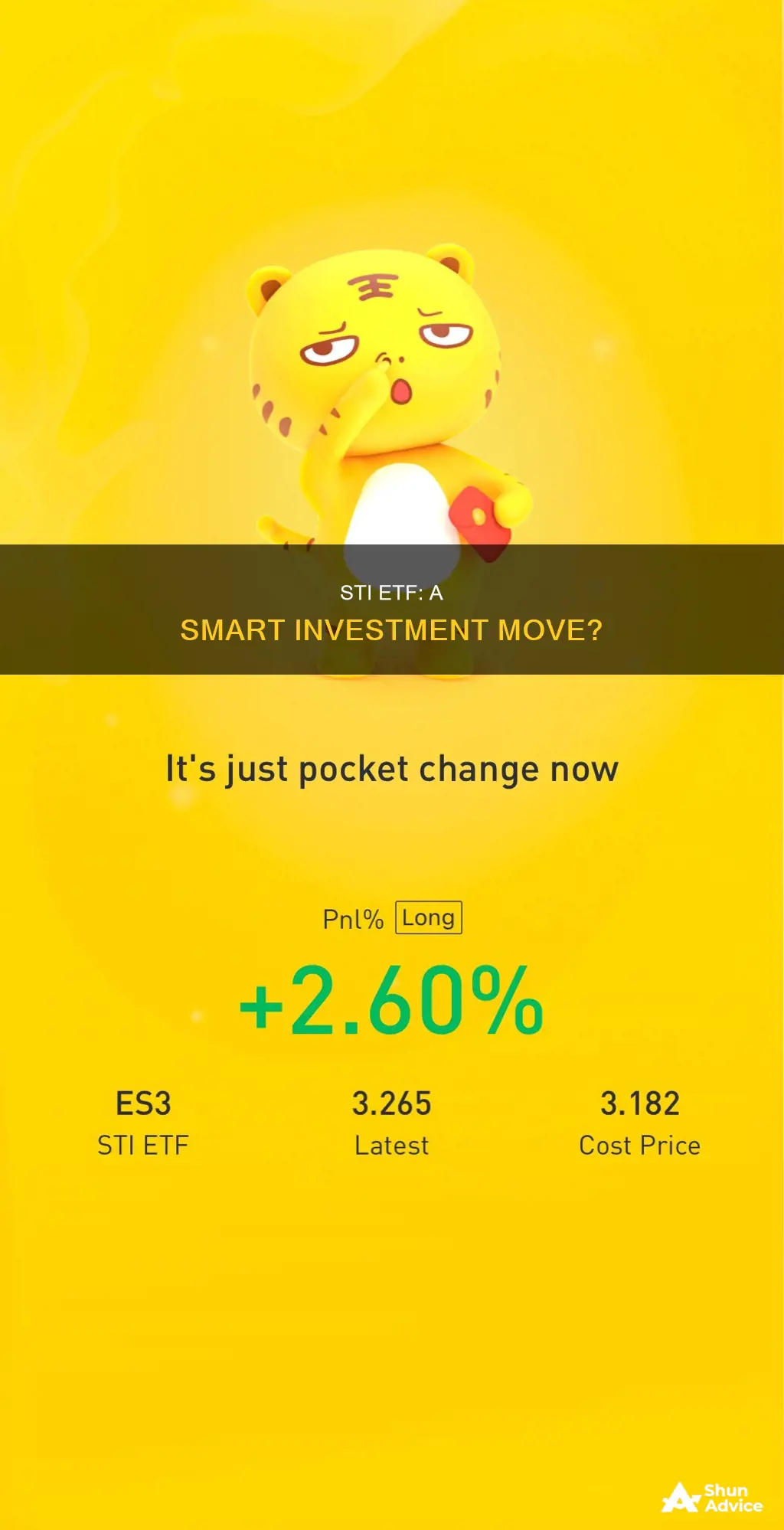
The Straits Times Index (STI) Exchange-Traded Fund (ETF) is an investment that tracks the performance of the STI, an index consisting of the 30 largest and most liquid companies listed in Singapore. The STI ETF is designed to be a straightforward way to diversify your investment portfolio at a low cost. It is passively managed, meaning it buys into a range of companies based on the STI's allocation, and has high liquidity. There are two STI ETFs to choose from: the SPDR STI ETF and the Nikko AM STI ETF. However, before investing in an STI ETF, it is important to consider the risks, such as country concentration risk and volatility during stock market crashes. Additionally, the STI is heavily weighted towards the financial sector, which may impact its performance in certain economic conditions.
| Characteristics | Values |
|---|---|
| What is STI ETF? | Straits Times Index (STI) Exchange-Traded Fund (ETF) |
| What does it track? | Straits Times Index (STI) |
| What is the STI? | An index consisting of the 30 largest and most liquid companies listed in Singapore |
| How does it work? | It buys and sells stocks to mirror the performance of the STI |
| Management type | Passively managed |
| Management fees | 0.3% (SPDR) to 0.35% (Nikko AM) |
| Historical performance | 2.5 times your money (CAGR of about 4.8%) in the last 30 years |
| Diversification | Lacks diversification, with 59% of the index in financials |
| Country concentration risk | Yes |
| Volatility | High |
| Dividend distribution | Semi-annually |
| Liquidity | High |
| Who should invest in STI ETF? | People with small investment capital, who don't know how to pick stocks or are lazy to do so, or who want to beat CPF Ordinary Account interest over the long run |
What You'll Learn

Advantages and disadvantages of investing in STI ETF
The Straits Times Index (STI) Exchange-Traded Fund (ETF) is a popular investment vehicle in Singapore, often recommended by financial advisors to young investors. It is designed for passive investors who are just starting their investment journey, as it is a straightforward way to diversify an investment portfolio at a low cost.
Advantages:
- Diversification: The STI ETF provides exposure to a basket of Singapore's top 30 companies across different industries and sectors, reducing the risk of investing in individual stocks.
- Low Cost: The STI ETF has lower expense ratios compared to actively managed funds, as it is passively managed and aims to replicate the index's performance.
- Tax Efficiency: As a passively managed portfolio, the STI ETF tends to realise fewer capital gains, resulting in potential tax savings for investors.
- Liquidity: The STI ETF is traded on the stock exchange, providing high liquidity and allowing investors to react quickly to market changes.
- Simplicity: The STI ETF is a simple and convenient way to invest in Singapore's top companies without the need to research and pick individual stocks.
Disadvantages:
- Country Concentration Risk: Investing solely in Singapore-listed stocks makes the STI ETF vulnerable to economic or political changes in Singapore.
- Lack of Diversification: The STI ETF is heavily weighted towards the financial sector, particularly local banks, which may impact its performance during financial crises.
- Limited Growth Potential: The STI ETF has underperformed compared to other global indices, such as the NASDAQ and Hang Seng, over the past 30 years.
- Intraday Pricing: Intraday price movements may induce longer-term investors to trade unnecessarily, potentially impacting their investment objectives.
- Higher Costs for Active Traders: While the STI ETF has lower expense ratios, active traders may find the brokerage commissions for frequent trading to be higher compared to investing in individual stocks.
- Lower Dividend Yields: The dividend yields of the STI ETF may be lower than those obtained by owning high-yielding stocks or groups of stocks.
ETFs: Active or Passive Investing Approach?
You may want to see also

SPDR STI ETF vs Nikko AM STI ETF
SPDR STI ETF and Nikko AM STI ETF are two exchange-traded funds (ETFs) that track the Straits Times Index (STI), a blue-chip index of the top 30 companies listed on the SGX (Singapore's Stock Exchange). Both ETFs are suitable for investors seeking a passive investment strategy and broad exposure to the Singapore market. Here is a detailed comparison between the two:
Fund Management:
SPDR STI ETF is managed by State Street Global Advisors Singapore Limited, a subsidiary of State Street Corporation, one of the largest fund management firms globally. Nikko AM STI ETF, on the other hand, is managed by Nikko Asset Management Asia Limited, one of the largest asset managers in Asia. Both fund managers are highly reputable and stable, making this a close match.
Track Record:
SPDR STI ETF was listed on the SGX in April 2002, while Nikko AM STI ETF was listed in February 2009. SPDR STI ETF's longer history provides a more extensive track record for evaluation. However, both ETFs have been in the market for over a decade, offering sufficient data for analysis.
Fund Size:
SPDR STI ETF has a larger fund size, with $1.613 billion under management compared to $649 million for Nikko AM STI ETF (as of March 2022). A larger fund size can be seen as more stable and may enjoy economies of scale, but it does not necessarily guarantee better performance.
Performance:
Evaluating the performance of these ETFs involves considering their returns, expense ratios, tracking errors, and dividend distribution.
Returns:
Both ETFs aim to track the STI as closely as possible. As of March 2022, the 1-year annualised return for SPDR STI ETF was 10.79%, while Nikko AM STI ETF delivered a slightly higher return of 10.83%. Over five years, SPDR STI ETF had an annualised return of 4.82%, and Nikko AM STI ETF delivered 4.69%. It's important to note that both ETFs achieved slightly lower returns compared to the benchmark STI.
Expense Ratio:
The expense ratio represents the fund's operating costs, including administrative and management fees. Both ETFs have an expense ratio of 0.3% per annum, which is relatively low and favourable for investors.
Tracking Error:
The tracking error measures how much an ETF's performance deviates from its underlying index. SPDR STI ETF has a rolling 1-year tracking error of 0.186%, while Nikko AM STI ETF reports a 3-year annualised tracking error of 0.14% (as of December 2022). The difference in reporting periods makes a direct comparison challenging, but Nikko AM STI ETF appears to have a slightly lower tracking error.
Dividend Distribution:
Both ETFs distribute dividends semi-annually and have a dividend yield of 3.48% (as per the SGX ETF Screener). However, they differ in payout timings, with SPDR STI ETF typically paying dividends around February and August, and Nikko AM STI ETF paying around January and July.
Both SPDR STI ETF and Nikko AM STI ETF are reputable and established ETFs tracking the STI. While SPDR STI ETF has a longer history and a larger fund size, Nikko AM STI ETF has demonstrated slightly better returns and a lower tracking error. The choice between the two depends on an investor's specific needs and preferences, with both ETFs offering broad exposure to the Singapore market and a passive investment strategy.
Invest Wisely: SP500 ETF Strategies for Beginners
You may want to see also

How to invest in STI ETF
How to Invest in the STI ETF
The Straits Times Index (STI) Exchange-Traded Fund (ETF) is an investment fund that tracks the performance of the STI, which consists of the top 30 companies listed on the Singapore Stock Exchange. The STI ETF is designed to mirror the performance of the STI index by buying and selling stocks to match the index's composition. It is considered a passive investment strategy as it does not require active stock picking.
There are two STI ETFs available: the SPDR STI ETF (SGX: ES3) and the Nikko AM STI ETF (SGX: G3B). Both have similar holdings and track the top 30 companies in Singapore. Here are the ways to invest in the STI ETF:
- Lump-Sum Investment: This method requires opening a Central Depository (CDP) account and an online brokerage account. Log into your brokerage account, ensure sufficient funds in your settlement account, select the desired STI ETF, and submit your trade with the desired price. If successful, the cost will be deducted from your settlement account, and the STI ETF stock will be allocated to your CDP or custodian account.
- Monthly Investment via Regular Shares Savings Plan (RSSP): This method is simpler as it does not require a CDP account. Open an RSSP account with a financial institution, such as DBS Bank Invest Saver, OCBC Bank Blue Chip Investment Plan, or PhillipCapital Share Builders Plan. Select the desired STI ETF and the amount to be deducted from your bank account monthly. The RSSP will automatically purchase the STI ETF on your behalf, and you will receive regular updates on your investments and dividends.
- Using CPF Ordinary Account: The STI ETF is one of the approved investments under the CPF Investment Scheme (CPFIS). You can apply for a CPFIS scheme account with a local bank and link it to your brokerage account. Indicate on your brokerage platform that you intend to use CPF monies to pay for the shares. You can invest any amount above the first S$20,000 in your CPF Ordinary Account into the STI ETF.
When deciding whether to invest in the STI ETF, it is essential to consider the benefits and risks. The STI ETF provides a simple and low-cost way to diversify your investment portfolio across Singapore's top companies. It is suitable for investors with small capital, those who don't know how to pick stocks, or those who prefer a passive investment approach. However, it is important to note that the STI ETF has a country concentration risk, as it is heavily weighted towards the financial sector and Singapore-centric companies. Therefore, it may be prudent to diversify your portfolio by allocating a portion of your investments to other regional or global indexes, REITs, or foreign equities.
A Simple Guide to Investing in SBI Nifty 50 ETF
You may want to see also

Risks of investing in STI ETF
The Straits Times Index (STI) Exchange-Traded Fund (ETF) is a low-cost, low-risk investment option that is often recommended for beginners. However, there are several risks associated with investing in the STI ETF that should be carefully considered. Here are some key risks to be aware of:
Volatile Stock History
The STI has experienced significant price drops that may be difficult for investors to withstand. For example, during the 2007-2008 financial crisis, the STI lost 50% of its value, compared to an average loss of 22% for conservative funds at that time. This level of volatility can be challenging for beginners to navigate and may deter them from investing further.
High Equity Investment
The STI ETF is a 100% equity investment, which means it carries a higher level of risk compared to other types of investments. While there is potential for high returns, there is also a significant possibility of substantial losses. Beginners may not be prepared for the level of risk associated with this type of investment.
Poor Diversification
The STI has a high concentration in the financial sector, with 56.4% of its companies being financials. This lack of diversification means that the performance of the STI is heavily dependent on the health of Singapore's financial industry. If the financial sector experiences difficulties, the STI is likely to be significantly impacted. Additionally, the STI only includes 30 companies, which further increases the concentration risk.
Country Concentration Risk
Investing solely in Singapore-listed stocks through the STI ETF exposes investors to country-specific risks. If Singapore's economic or political conditions change, or if the country's investment appeal diminishes, the stocks in the STI ETF may underperform compared to stocks in other countries. This risk is compounded by the fact that many investors already have their jobs, property, and Central Provident Fund (CPF) monies tied to Singapore.
Tracking Error
The STI ETF may not perfectly mirror the performance of its underlying index due to factors such as bid-ask spread, transaction costs, and liquidity of the underlying stocks. This deviation, known as tracking error, can affect the returns of the STI ETF and introduce additional risk.
Stock Market Volatility
The price of the STI ETF is subject to significant fluctuations, particularly during stock market crashes. Investors need to be prepared for potential price swings and understand the risks associated with investing in volatile assets.
Hedging Your S&P 500 ETF: Strategies for Success
You may want to see also

Who should invest in an STI ETF?
The Straits Times Index (STI) Exchange-Traded Fund (ETF) is an investment that tracks the performance of the STI, an index of the top 30 companies listed on the Singapore Stock Exchange. As such, it is a simple way to invest in Singapore's top companies and is ideal for passive investors who are just starting out.
- You have a small investment capital: With limited funds, you can still invest in 30 stocks, providing sufficient diversification for your portfolio.
- You don't know how to pick stocks: Most investors, including fund managers, are not able to beat the index by picking stocks. Therefore, investing in the index itself is a safer approach.
- You are lazy to pick stocks: Not everyone enjoys spending time and effort on stock picking. In this case, ETFs are a good option as they allow investors to park their money in index ETFs and grow their wealth passively.
- You want to beat the CPF Ordinary Account interest over the long run: The CPF OA offered an interest rate of up to 2.5% per year between 1 October 2021 and 31 December 2021. In comparison, the annualised returns of SPDR STI ETF and Nikko AM STI ETF were 6.38% and 8.25%, respectively, since their inception in 2002 and 2009.
- You want to invest in the future of Singapore: Singapore has experienced significant economic growth, and its companies have expanded their influence in Asia and globally. Investing in an STI ETF allows you to bet on the continued success of these companies and Singapore's position as a regional hub.
However, it is important to note that the STI ETF may not be suitable for everyone. Some reasons why you might not want to invest in an STI ETF include:
- Country concentration risk: The STI ETF invests only in Singapore-listed stocks, making it highly sensitive to changes in Singapore's economic and political conditions.
- Lack of diversification: The STI is heavily weighted towards the financial sector, with DBS, OCBC, and UOB making up about 40% of the index. This lack of diversification means that an investment in the STI ETF is essentially a bet on the performance of Singapore's financial sector.
- Historical performance: While past performance does not guarantee future results, the STI has underperformed compared to other major global indices like the NASDAQ and S&P 500 over the past 30 years.
Ultimately, the decision to invest in an STI ETF depends on your investment goals, risk tolerance, and time horizon. It is recommended to do your own research and consult with a financial advisor before making any investment decisions.
A Beginner's Guide to ETF Investing on Robinhood
You may want to see also
Frequently asked questions
The Straits Times Index (STI) Exchange-Traded Fund (ETF) is an investment fund that tracks the performance of the STI, which consists of the top 30 largest and most liquid companies listed in Singapore. The STI ETF is a passive investment strategy that aims to mirror the composition and performance of the STI by buying and selling stocks.
Investing in the STI ETF provides a simple and low-cost way to diversify your investment portfolio. It offers exposure to a range of companies within the ETF, including well-known local companies from various industries and sectors. The STI ETF also has relatively low management fees compared to mutual funds.
One of the main risks is country concentration risk, as the STI ETF invests solely in Singapore-listed stocks. This makes it highly sensitive to changes in Singapore's economic and political conditions. Additionally, the STI ETF may not perfectly mirror its underlying index due to factors such as transaction costs and liquidity issues.
There are a few ways to invest in the STI ETF, including buying through a brokerage, using a monthly investment plan, or investing through your Central Provident Fund (CPF) Ordinary Account. It's important to compare the fees and features of different investment platforms before deciding.
Alternatives to the STI ETF include investing in individual Singapore equities, regional or global indexes, foreign equities, or REITs. Diversifying your portfolio across different asset classes and geographies can help manage risk and potentially improve returns.







